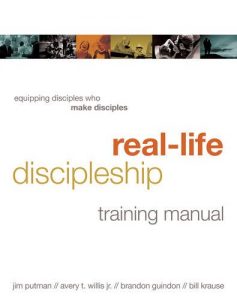As a senior pastor of Real Life Ministries and a board member with the Relational Discipleship Network, I am passionate about the importance of a relational environment to making disciples of Jesus. Small Groups are one such relational environment that works well when trying to create a culture of disciple making in your church. Because we talk about them so often, sometimes people mistakenly get the idea that Small Groups are the goal – that if you are a church that has developed Small Groups you have hit the target.
However, the target is not a relational environment. A relational environment is the vehicle we travel in to get to the destination. A church is successful when everyone in the church is in the game, maturing into disciples who can reproduce other disciples. The purpose of the church has been, and should always be, to make disciples of Jesus.
You can have small groups and not make disciples – small groups exist throughout our society. From regulars at a neighborhood bar to a sports team that plays in a league, small groups are all around us. They are not a new concept by any means. However, small groups formed for the purpose of making disciples of Jesus are a less familiar concept – but that is the method Jesus used when making his 12 disciples during his time on earth.
There must be a combination of specific components that are used in conjunction WITH a small group in order to make disciples. Small Groups are the vehicle - not the destination.. #discipleship Share on XIt is not something that just happens by chance – there must be a combination of specific components that are used in conjunction with a small group in order to make disciples. I like to use the analogy of a road trip to explain the different components and the part each one plays:
 An Intentional Leader: A car doesn’t get very far unless there is someone in the drivers seat with a key. This leader is driving the group towards the destination, or purpose. It helps if the leader has already made the trip and is familiar with the route!
An Intentional Leader: A car doesn’t get very far unless there is someone in the drivers seat with a key. This leader is driving the group towards the destination, or purpose. It helps if the leader has already made the trip and is familiar with the route!
 A Relational Environment: The driver has to have something that drives – and something that accommodates passengers. Relationships are what God uses to communicate His truth and help people grow. Without relationships, the journey of discipleship can be boring and ineffective. Motivation can die because no one is there to celebrate a breakthrough or support us when we struggle. Relationships create the environment where discipleship happens best.
A Relational Environment: The driver has to have something that drives – and something that accommodates passengers. Relationships are what God uses to communicate His truth and help people grow. Without relationships, the journey of discipleship can be boring and ineffective. Motivation can die because no one is there to celebrate a breakthrough or support us when we struggle. Relationships create the environment where discipleship happens best.
 A Map – The Reproducible Process: The third component for this successful journey is a map. Using a map helps eliminate the risk of getting lost or off track from your destination. The road map for making disciples is the reproducible process. This process allows us to measure a disciple’s progress – to figure out where they are in the journey so we have a better idea of what they need. And it teaches the disciple the route, so that they in turn can share it with others.
A Map – The Reproducible Process: The third component for this successful journey is a map. Using a map helps eliminate the risk of getting lost or off track from your destination. The road map for making disciples is the reproducible process. This process allows us to measure a disciple’s progress – to figure out where they are in the journey so we have a better idea of what they need. And it teaches the disciple the route, so that they in turn can share it with others.
 The entire discipleship journey has a biblical foundation. In other words, these three elements of the discipleship journey are modeled in Scripture, especially in the life of Jesus and in the early church. You can make a disciple without a biblical foundation, but you won’t be making a disciple of Jesus. When people talk about Real Life Ministries, we love to be known as a Disciple Making Church, rather than a Small Group Church. Small Groups are a core essential to us, but they are the vehicle we use to reach our destination – which is being a Disciple Making Church.
The entire discipleship journey has a biblical foundation. In other words, these three elements of the discipleship journey are modeled in Scripture, especially in the life of Jesus and in the early church. You can make a disciple without a biblical foundation, but you won’t be making a disciple of Jesus. When people talk about Real Life Ministries, we love to be known as a Disciple Making Church, rather than a Small Group Church. Small Groups are a core essential to us, but they are the vehicle we use to reach our destination – which is being a Disciple Making Church.
Scroll down to watch a video of Jim explaining this concept:
You can read more on this topic in The Real Life Discipleship Training Manual
You may also be interested in the following posts:
The 5 Stages Of Growth Of A Disciple (Free Resource Download)
5 Questions That Will Start Your Day With A Discipleship Mindset







